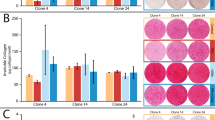Summary
Clonal osteoblastic cell lines were isolated from neonatal rat calvariae and characterized with regard to a number of features associated with authentic osteoblasts. These included elevated alkaline phosphatase activity (relative to fibroblasts), PTH and PGE2-stimulated increases in cAMP, the predominant synthesis of type 1 collagen, and the production of a mineralized matrixin vitro. By these criteria, five clones with osteoblast-like phenotypes were identified (ROB-C8a, C11, C20, C23, and C26) which varied somewhat in shape, levels of alkaline phosphatase activity, and in responsiveness to PTH and PGE2, C11, C20, and C23 responded to both effector substances, whereas C8a only responded to PTH and C26 only responded strongly to PGE2. Upon further examination, two of the clones (C23 and C26) were also found to exhibit significant muscle myotube formation after reaching confluence, and three of the clones (C8a, C11, and C26) showed marked adipocyte differentiation after treatment with dexamethasone. Overall, these data add further supporting documentation to (1) the suspected ontogenetic relationships of osteoblasts to other connective tissue cells, and (2) the concept that osteoblastic cells associated with neonatal rat calvariae are in various stable stages of differentiation and developmental commitment.
Similar content being viewed by others
References
Majeska RJ, Rodan SB, Rodan GA (1980) Parathyroid hormone responsive clonal cell lines from rat osteosarcoma. Endocrinology 107:1494–1503
Partridge NC, Alcon D, Michelangeli VP, Ryan G, Martin TJ (1983) Morphological and biochemical characterization of four clonal osteogenic sarcoma cell lines of rat origin. Cancer Res 43:4308–4314
Aubin JE, Heersche JNM, Merrilees MJ, Sodek J (1982) Isolation of bone cell clones with differences in growth, hormone responses, and extracellular matrix production. J Cell Biol 92:452–461
Sudo J, Kodama H, Amagai Y, Yamamoto S, Kasai S (1983) In vitro differentiation and calcification in a new clonal osteogenic cell line derived from newborn mouse calvaria. J Cell Biol 96:191–198
Grigoriadis AE, Heersche JNH, Aubin JE (1988) Differentiation of muscle, fat, cartilage, and bone from progenitor cells present in a bone-derived clonal cell population: effect of dexamethasone. J Cell Biol 106:2139–2151
Heath JK, Rodan SB, Yoon K, Rodan GA (1989) Rat calvarial cell lines immortalized with SV-40 large T antigen: constitutive and retinoic acid-inducible expression of osteoblastic features. Endocrinology 124:3060–3068
Guenther HL, Hofstetter W, Stutzer A, Muhlbauer R, Fleish H (1989) Evidence for heterogeneity of the osteoblastic phenotype determined with clonal rat bone cells established from transforming growth factor-B-induced cell colonies grown anchorage independently in semisolid medium. Endocrinology 125:2092–2102
Kellermann O, Buc-Caron MH, Marie PJ, Lamblin D, Jacob F (1990) An immortalized osteogenic cell line derived from mouse teratocarcinoma is able to mineralize in vivo and in vitro. J Cell Biol 110:123–132
Owen M (1988) Marrow stromal stem cells. J Cell Sci (suppl) 10:63–76
Caplan AJ, Stoolmilaer AC (1973) Control of chondrogenic expression in mesodermal cells of embryonic limb. Proc Natl Acad Sci USA 70:1713–1717
Osdoby P, Caplan AJ (1976) The possible differentiation of osteogenic elements in vitro from chick limb mesodermal cells. I. Morphological evidence. Dev Biol 52:283–299
Reddi AH, Huggins CB (1972) Biochemical sequences in the treatment of normal fibroblasts in adolescent rats. Proc Natl Acad Sci USA 69:1601–1605
Sykes B, Puddle B, Francis M, Smith R (1976) The estimation of two collagens from human dermis by interrupted gel electrophoresis. Biochem Biophys Res Commun 72:1472–1480
Kream BE, Rowe D, Smith MD, Maher V, Majeska R (1986) Hormonal regulation of collagen synthesis in a clonal rat osteosarcoma cell line. Endocrinology 119:1922–1928
Rodan GA, Rodan SB (1984) Expression of the osteoblastic phenotype. In: Pech WA (ed) Bone and mineral research, vol. 2. Elsevier Science Publishing, Amsterdam, pp 244–285
Fridenstein AJ, Piatetzky-Shapiro II, Petrakova KV (1966) Osteogenesis in transplants of bone marrow cells. J Embryol Exp Morph 16:381–390
Taylor SM, Jones PA (1979) Multiple new phenotypes induced in 10T1/2 and 3T3 cells treated with 5-azacytidine. Cell 17:771–779
Author information
Authors and Affiliations
Rights and permissions
About this article
Cite this article
Yamaguchi, A., Kahn, A.J. Clonal osteogenic cell lines express myogenic and adipocytic developmental potential. Calcif Tissue Int 49, 221–225 (1991). https://doi.org/10.1007/BF02556122
Received:
Issue Date:
DOI: https://doi.org/10.1007/BF02556122




